Financial Systems and Auditing: Risk Assessment and Audit Procedures
VerifiedAdded on 2019/12/03
|13
|4290
|305
Report
AI Summary
This report delves into the realm of financial systems and auditing, providing a comprehensive overview of key concepts and practical applications. It begins by examining the purpose, use, and importance of various accounting records, including ledgers, invoices, and prime entry books, along with the significance of accounting concepts such as money measurement, going concern, and accrual. The report then explores the factors influencing the nature and structure of an organization's accounting system, considering both manual and computerized approaches. A significant portion of the report is dedicated to business risk, dissecting its various components such as operational, liquidity, financial, market, and regulatory risks, with a particular focus on the risk of fraud. The analysis extends to control systems, emphasizing their role in fraud identification and detection. Finally, the report outlines audit procedures for a manufacturing company, including planning, test selection, and documentation, culminating in drafts of an audit report and management letters.
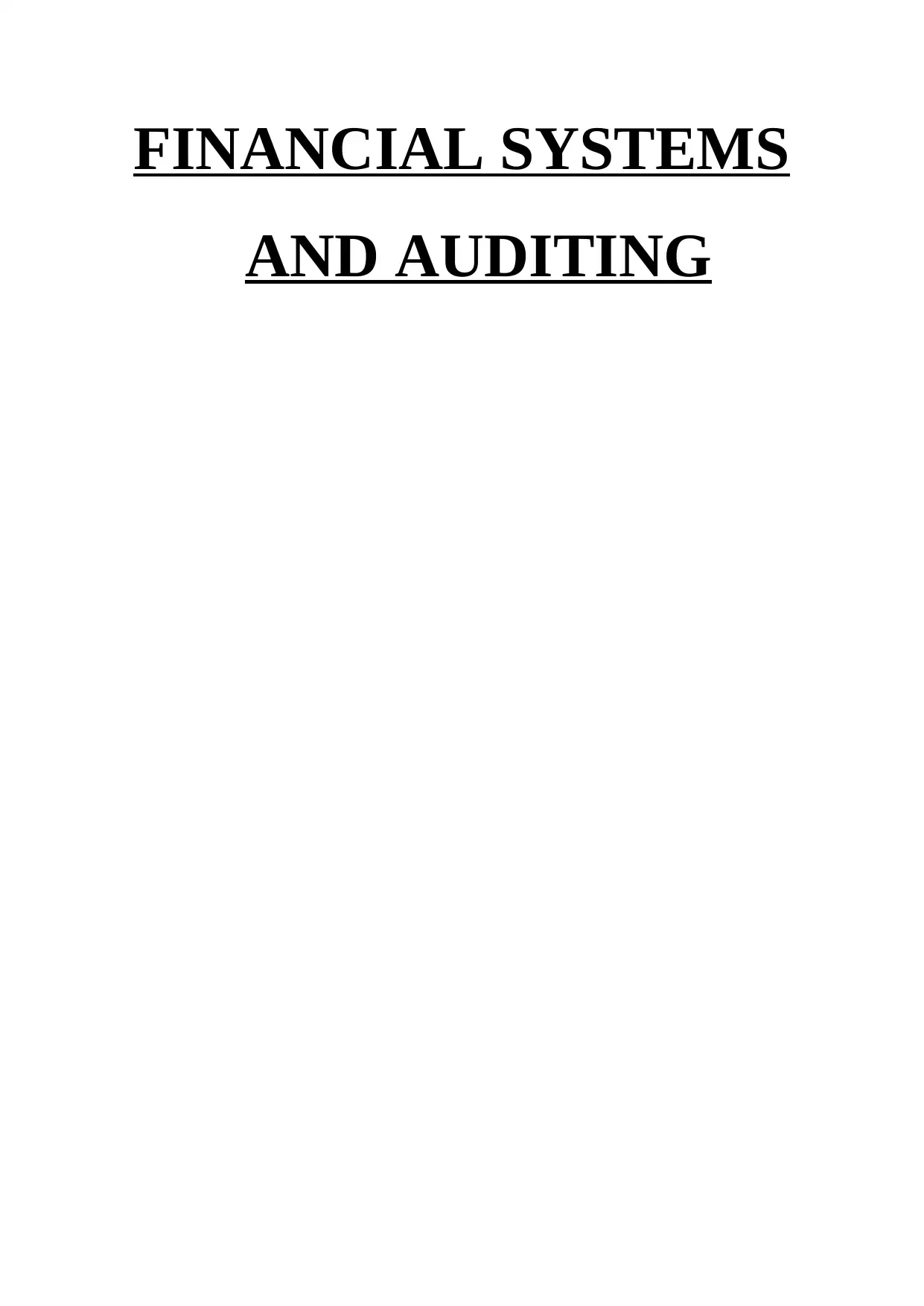
FINANCIAL SYSTEMS
AND AUDITING
AND AUDITING
Paraphrase This Document
Need a fresh take? Get an instant paraphrase of this document with our AI Paraphraser
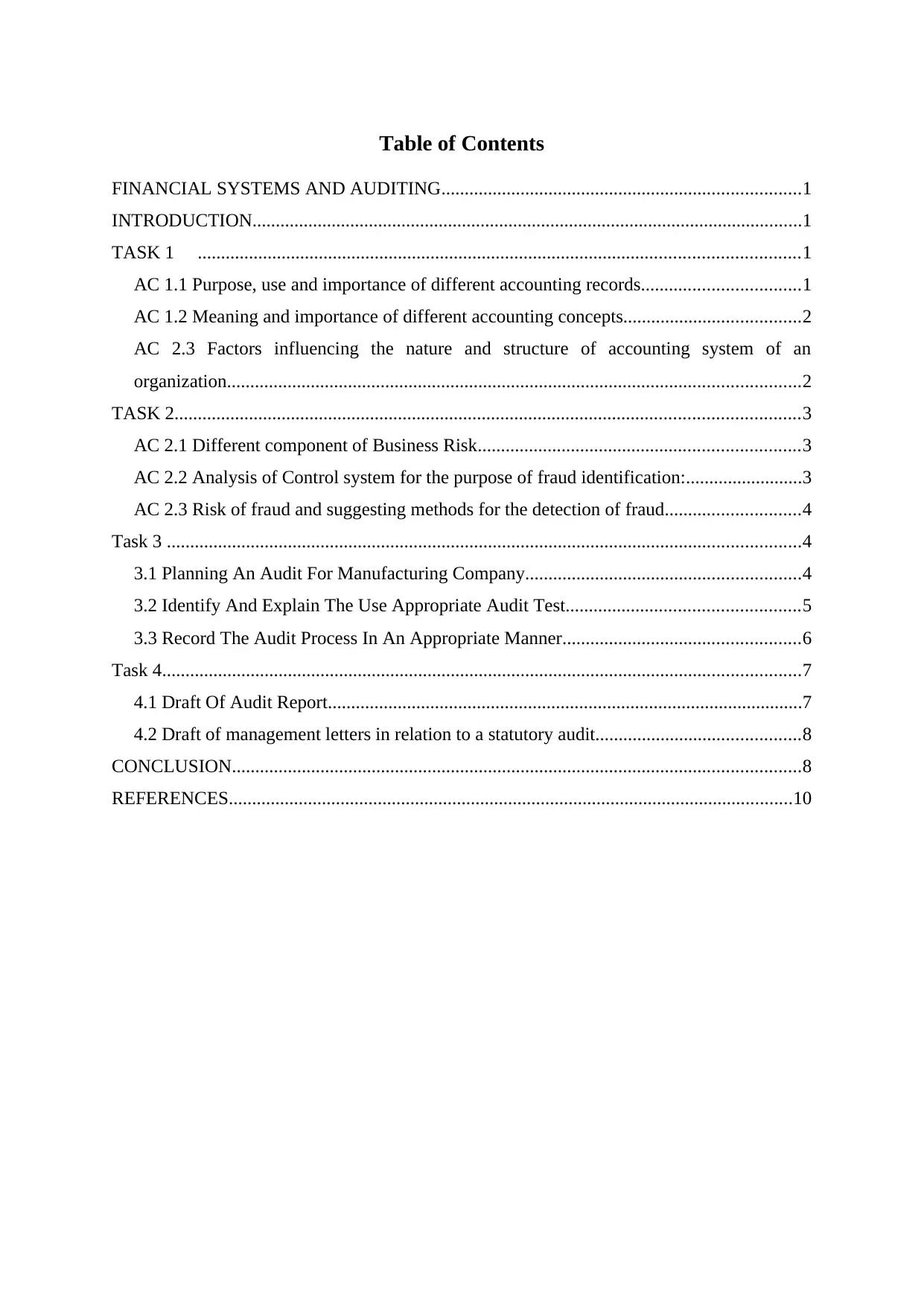
Table of Contents
FINANCIAL SYSTEMS AND AUDITING.............................................................................1
INTRODUCTION......................................................................................................................1
TASK 1 .................................................................................................................................1
AC 1.1 Purpose, use and importance of different accounting records..................................1
AC 1.2 Meaning and importance of different accounting concepts......................................2
AC 2.3 Factors influencing the nature and structure of accounting system of an
organization...........................................................................................................................2
TASK 2......................................................................................................................................3
AC 2.1 Different component of Business Risk.....................................................................3
AC 2.2 Analysis of Control system for the purpose of fraud identification:.........................3
AC 2.3 Risk of fraud and suggesting methods for the detection of fraud.............................4
Task 3 ........................................................................................................................................4
3.1 Planning An Audit For Manufacturing Company...........................................................4
3.2 Identify And Explain The Use Appropriate Audit Test..................................................5
3.3 Record The Audit Process In An Appropriate Manner...................................................6
Task 4.........................................................................................................................................7
4.1 Draft Of Audit Report......................................................................................................7
4.2 Draft of management letters in relation to a statutory audit............................................8
CONCLUSION..........................................................................................................................8
REFERENCES.........................................................................................................................10
FINANCIAL SYSTEMS AND AUDITING.............................................................................1
INTRODUCTION......................................................................................................................1
TASK 1 .................................................................................................................................1
AC 1.1 Purpose, use and importance of different accounting records..................................1
AC 1.2 Meaning and importance of different accounting concepts......................................2
AC 2.3 Factors influencing the nature and structure of accounting system of an
organization...........................................................................................................................2
TASK 2......................................................................................................................................3
AC 2.1 Different component of Business Risk.....................................................................3
AC 2.2 Analysis of Control system for the purpose of fraud identification:.........................3
AC 2.3 Risk of fraud and suggesting methods for the detection of fraud.............................4
Task 3 ........................................................................................................................................4
3.1 Planning An Audit For Manufacturing Company...........................................................4
3.2 Identify And Explain The Use Appropriate Audit Test..................................................5
3.3 Record The Audit Process In An Appropriate Manner...................................................6
Task 4.........................................................................................................................................7
4.1 Draft Of Audit Report......................................................................................................7
4.2 Draft of management letters in relation to a statutory audit............................................8
CONCLUSION..........................................................................................................................8
REFERENCES.........................................................................................................................10
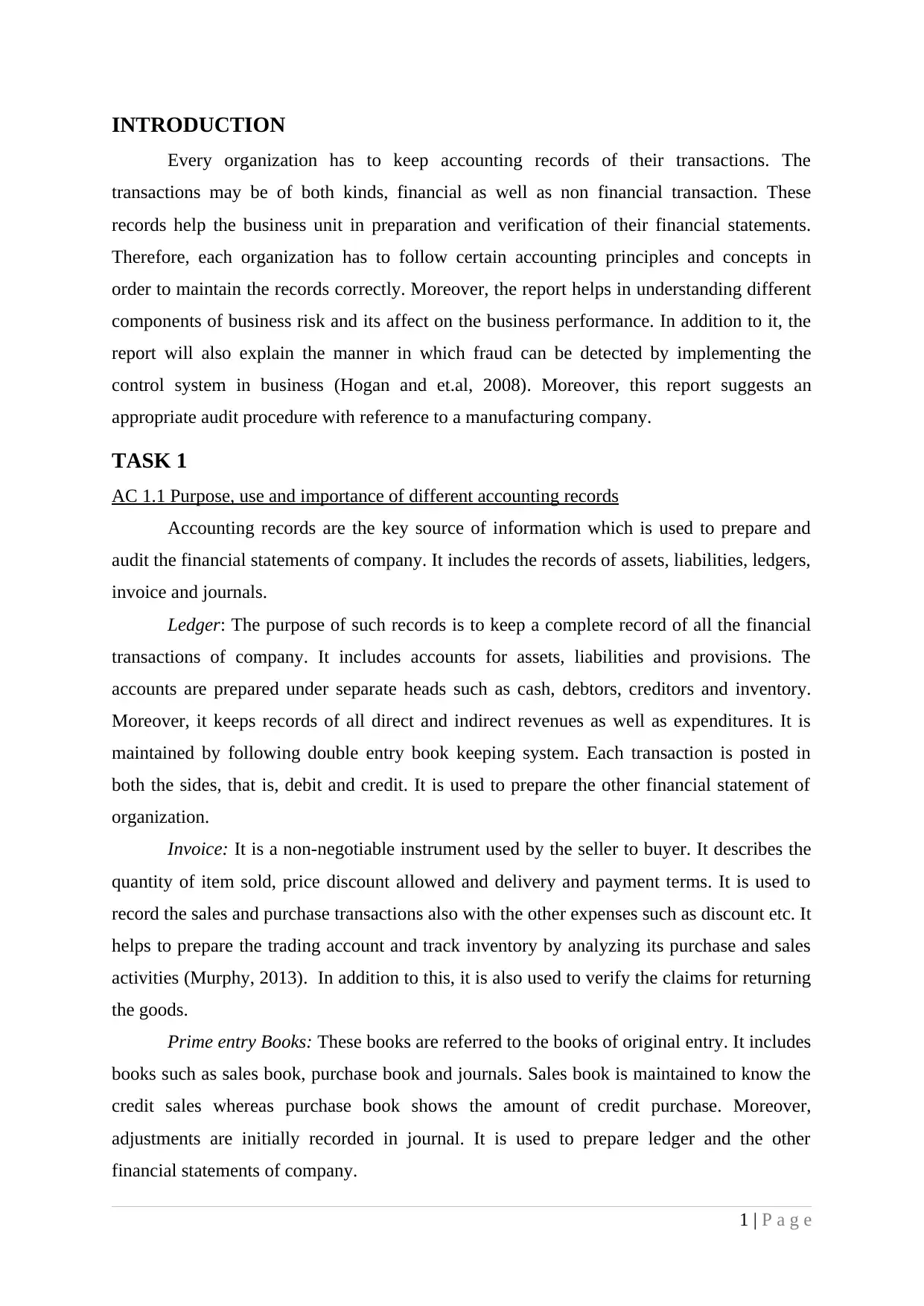
INTRODUCTION
Every organization has to keep accounting records of their transactions. The
transactions may be of both kinds, financial as well as non financial transaction. These
records help the business unit in preparation and verification of their financial statements.
Therefore, each organization has to follow certain accounting principles and concepts in
order to maintain the records correctly. Moreover, the report helps in understanding different
components of business risk and its affect on the business performance. In addition to it, the
report will also explain the manner in which fraud can be detected by implementing the
control system in business (Hogan and et.al, 2008). Moreover, this report suggests an
appropriate audit procedure with reference to a manufacturing company.
TASK 1
AC 1.1 Purpose, use and importance of different accounting records
Accounting records are the key source of information which is used to prepare and
audit the financial statements of company. It includes the records of assets, liabilities, ledgers,
invoice and journals.
Ledger: The purpose of such records is to keep a complete record of all the financial
transactions of company. It includes accounts for assets, liabilities and provisions. The
accounts are prepared under separate heads such as cash, debtors, creditors and inventory.
Moreover, it keeps records of all direct and indirect revenues as well as expenditures. It is
maintained by following double entry book keeping system. Each transaction is posted in
both the sides, that is, debit and credit. It is used to prepare the other financial statement of
organization.
Invoice: It is a non-negotiable instrument used by the seller to buyer. It describes the
quantity of item sold, price discount allowed and delivery and payment terms. It is used to
record the sales and purchase transactions also with the other expenses such as discount etc. It
helps to prepare the trading account and track inventory by analyzing its purchase and sales
activities (Murphy, 2013). In addition to this, it is also used to verify the claims for returning
the goods.
Prime entry Books: These books are referred to the books of original entry. It includes
books such as sales book, purchase book and journals. Sales book is maintained to know the
credit sales whereas purchase book shows the amount of credit purchase. Moreover,
adjustments are initially recorded in journal. It is used to prepare ledger and the other
financial statements of company.
1 | P a g e
Every organization has to keep accounting records of their transactions. The
transactions may be of both kinds, financial as well as non financial transaction. These
records help the business unit in preparation and verification of their financial statements.
Therefore, each organization has to follow certain accounting principles and concepts in
order to maintain the records correctly. Moreover, the report helps in understanding different
components of business risk and its affect on the business performance. In addition to it, the
report will also explain the manner in which fraud can be detected by implementing the
control system in business (Hogan and et.al, 2008). Moreover, this report suggests an
appropriate audit procedure with reference to a manufacturing company.
TASK 1
AC 1.1 Purpose, use and importance of different accounting records
Accounting records are the key source of information which is used to prepare and
audit the financial statements of company. It includes the records of assets, liabilities, ledgers,
invoice and journals.
Ledger: The purpose of such records is to keep a complete record of all the financial
transactions of company. It includes accounts for assets, liabilities and provisions. The
accounts are prepared under separate heads such as cash, debtors, creditors and inventory.
Moreover, it keeps records of all direct and indirect revenues as well as expenditures. It is
maintained by following double entry book keeping system. Each transaction is posted in
both the sides, that is, debit and credit. It is used to prepare the other financial statement of
organization.
Invoice: It is a non-negotiable instrument used by the seller to buyer. It describes the
quantity of item sold, price discount allowed and delivery and payment terms. It is used to
record the sales and purchase transactions also with the other expenses such as discount etc. It
helps to prepare the trading account and track inventory by analyzing its purchase and sales
activities (Murphy, 2013). In addition to this, it is also used to verify the claims for returning
the goods.
Prime entry Books: These books are referred to the books of original entry. It includes
books such as sales book, purchase book and journals. Sales book is maintained to know the
credit sales whereas purchase book shows the amount of credit purchase. Moreover,
adjustments are initially recorded in journal. It is used to prepare ledger and the other
financial statements of company.
1 | P a g e
⊘ This is a preview!⊘
Do you want full access?
Subscribe today to unlock all pages.

Trusted by 1+ million students worldwide
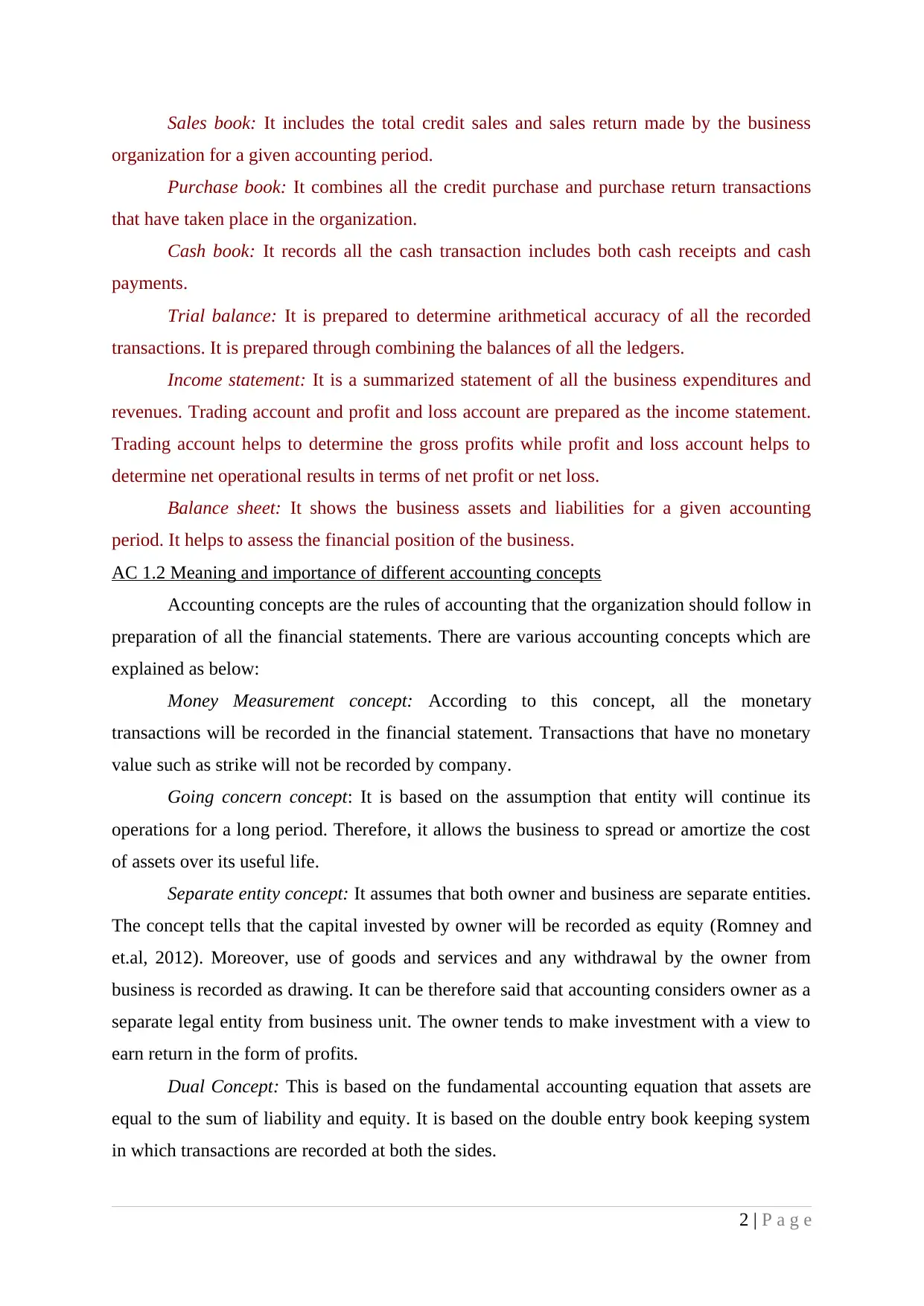
Sales book: It includes the total credit sales and sales return made by the business
organization for a given accounting period.
Purchase book: It combines all the credit purchase and purchase return transactions
that have taken place in the organization.
Cash book: It records all the cash transaction includes both cash receipts and cash
payments.
Trial balance: It is prepared to determine arithmetical accuracy of all the recorded
transactions. It is prepared through combining the balances of all the ledgers.
Income statement: It is a summarized statement of all the business expenditures and
revenues. Trading account and profit and loss account are prepared as the income statement.
Trading account helps to determine the gross profits while profit and loss account helps to
determine net operational results in terms of net profit or net loss.
Balance sheet: It shows the business assets and liabilities for a given accounting
period. It helps to assess the financial position of the business.
AC 1.2 Meaning and importance of different accounting concepts
Accounting concepts are the rules of accounting that the organization should follow in
preparation of all the financial statements. There are various accounting concepts which are
explained as below:
Money Measurement concept: According to this concept, all the monetary
transactions will be recorded in the financial statement. Transactions that have no monetary
value such as strike will not be recorded by company.
Going concern concept: It is based on the assumption that entity will continue its
operations for a long period. Therefore, it allows the business to spread or amortize the cost
of assets over its useful life.
Separate entity concept: It assumes that both owner and business are separate entities.
The concept tells that the capital invested by owner will be recorded as equity (Romney and
et.al, 2012). Moreover, use of goods and services and any withdrawal by the owner from
business is recorded as drawing. It can be therefore said that accounting considers owner as a
separate legal entity from business unit. The owner tends to make investment with a view to
earn return in the form of profits.
Dual Concept: This is based on the fundamental accounting equation that assets are
equal to the sum of liability and equity. It is based on the double entry book keeping system
in which transactions are recorded at both the sides.
2 | P a g e
organization for a given accounting period.
Purchase book: It combines all the credit purchase and purchase return transactions
that have taken place in the organization.
Cash book: It records all the cash transaction includes both cash receipts and cash
payments.
Trial balance: It is prepared to determine arithmetical accuracy of all the recorded
transactions. It is prepared through combining the balances of all the ledgers.
Income statement: It is a summarized statement of all the business expenditures and
revenues. Trading account and profit and loss account are prepared as the income statement.
Trading account helps to determine the gross profits while profit and loss account helps to
determine net operational results in terms of net profit or net loss.
Balance sheet: It shows the business assets and liabilities for a given accounting
period. It helps to assess the financial position of the business.
AC 1.2 Meaning and importance of different accounting concepts
Accounting concepts are the rules of accounting that the organization should follow in
preparation of all the financial statements. There are various accounting concepts which are
explained as below:
Money Measurement concept: According to this concept, all the monetary
transactions will be recorded in the financial statement. Transactions that have no monetary
value such as strike will not be recorded by company.
Going concern concept: It is based on the assumption that entity will continue its
operations for a long period. Therefore, it allows the business to spread or amortize the cost
of assets over its useful life.
Separate entity concept: It assumes that both owner and business are separate entities.
The concept tells that the capital invested by owner will be recorded as equity (Romney and
et.al, 2012). Moreover, use of goods and services and any withdrawal by the owner from
business is recorded as drawing. It can be therefore said that accounting considers owner as a
separate legal entity from business unit. The owner tends to make investment with a view to
earn return in the form of profits.
Dual Concept: This is based on the fundamental accounting equation that assets are
equal to the sum of liability and equity. It is based on the double entry book keeping system
in which transactions are recorded at both the sides.
2 | P a g e
Paraphrase This Document
Need a fresh take? Get an instant paraphrase of this document with our AI Paraphraser
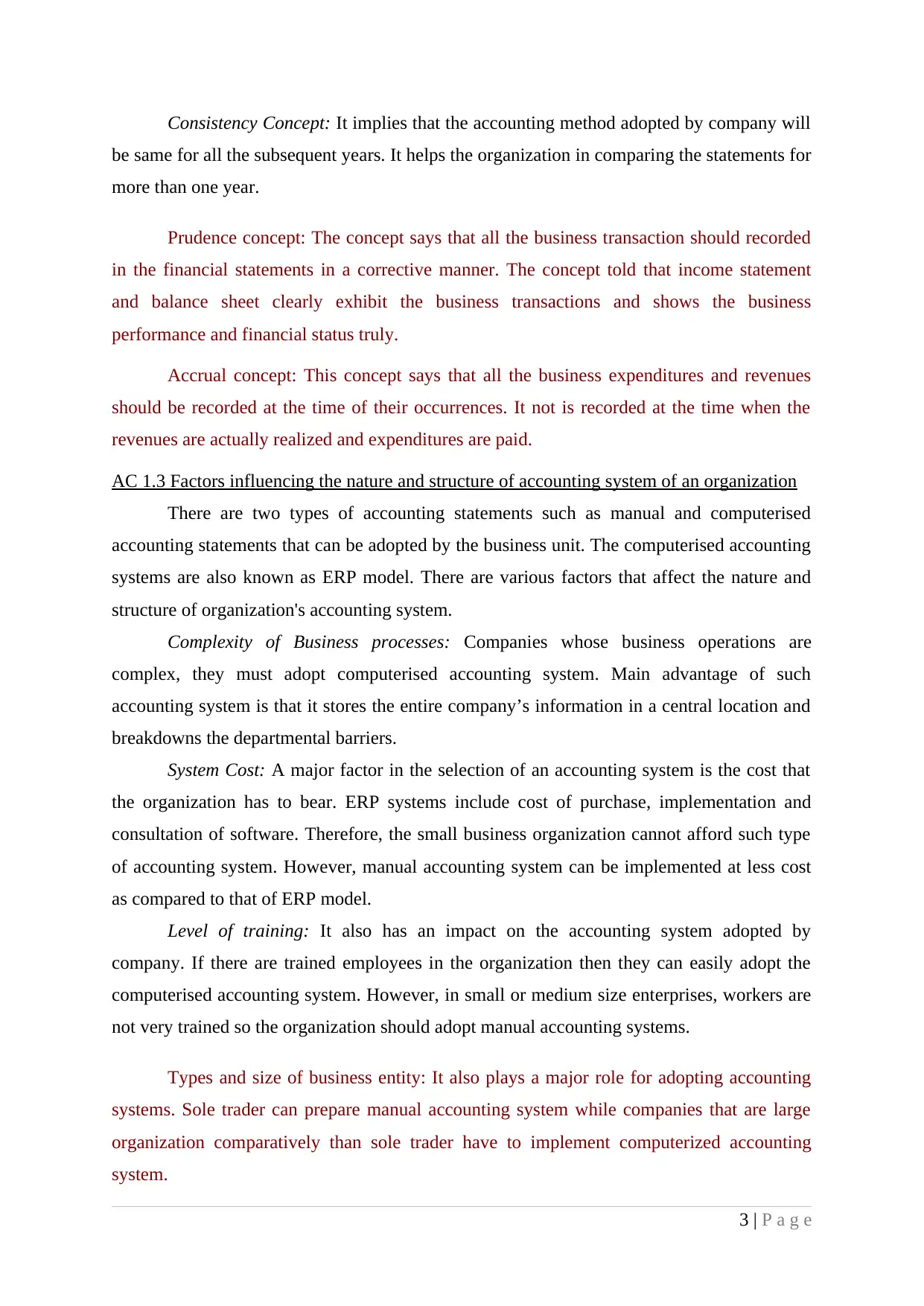
Consistency Concept: It implies that the accounting method adopted by company will
be same for all the subsequent years. It helps the organization in comparing the statements for
more than one year.
Prudence concept: The concept says that all the business transaction should recorded
in the financial statements in a corrective manner. The concept told that income statement
and balance sheet clearly exhibit the business transactions and shows the business
performance and financial status truly.
Accrual concept: This concept says that all the business expenditures and revenues
should be recorded at the time of their occurrences. It not is recorded at the time when the
revenues are actually realized and expenditures are paid.
AC 1.3 Factors influencing the nature and structure of accounting system of an organization
There are two types of accounting statements such as manual and computerised
accounting statements that can be adopted by the business unit. The computerised accounting
systems are also known as ERP model. There are various factors that affect the nature and
structure of organization's accounting system.
Complexity of Business processes: Companies whose business operations are
complex, they must adopt computerised accounting system. Main advantage of such
accounting system is that it stores the entire company’s information in a central location and
breakdowns the departmental barriers.
System Cost: A major factor in the selection of an accounting system is the cost that
the organization has to bear. ERP systems include cost of purchase, implementation and
consultation of software. Therefore, the small business organization cannot afford such type
of accounting system. However, manual accounting system can be implemented at less cost
as compared to that of ERP model.
Level of training: It also has an impact on the accounting system adopted by
company. If there are trained employees in the organization then they can easily adopt the
computerised accounting system. However, in small or medium size enterprises, workers are
not very trained so the organization should adopt manual accounting systems.
Types and size of business entity: It also plays a major role for adopting accounting
systems. Sole trader can prepare manual accounting system while companies that are large
organization comparatively than sole trader have to implement computerized accounting
system.
3 | P a g e
be same for all the subsequent years. It helps the organization in comparing the statements for
more than one year.
Prudence concept: The concept says that all the business transaction should recorded
in the financial statements in a corrective manner. The concept told that income statement
and balance sheet clearly exhibit the business transactions and shows the business
performance and financial status truly.
Accrual concept: This concept says that all the business expenditures and revenues
should be recorded at the time of their occurrences. It not is recorded at the time when the
revenues are actually realized and expenditures are paid.
AC 1.3 Factors influencing the nature and structure of accounting system of an organization
There are two types of accounting statements such as manual and computerised
accounting statements that can be adopted by the business unit. The computerised accounting
systems are also known as ERP model. There are various factors that affect the nature and
structure of organization's accounting system.
Complexity of Business processes: Companies whose business operations are
complex, they must adopt computerised accounting system. Main advantage of such
accounting system is that it stores the entire company’s information in a central location and
breakdowns the departmental barriers.
System Cost: A major factor in the selection of an accounting system is the cost that
the organization has to bear. ERP systems include cost of purchase, implementation and
consultation of software. Therefore, the small business organization cannot afford such type
of accounting system. However, manual accounting system can be implemented at less cost
as compared to that of ERP model.
Level of training: It also has an impact on the accounting system adopted by
company. If there are trained employees in the organization then they can easily adopt the
computerised accounting system. However, in small or medium size enterprises, workers are
not very trained so the organization should adopt manual accounting systems.
Types and size of business entity: It also plays a major role for adopting accounting
systems. Sole trader can prepare manual accounting system while companies that are large
organization comparatively than sole trader have to implement computerized accounting
system.
3 | P a g e
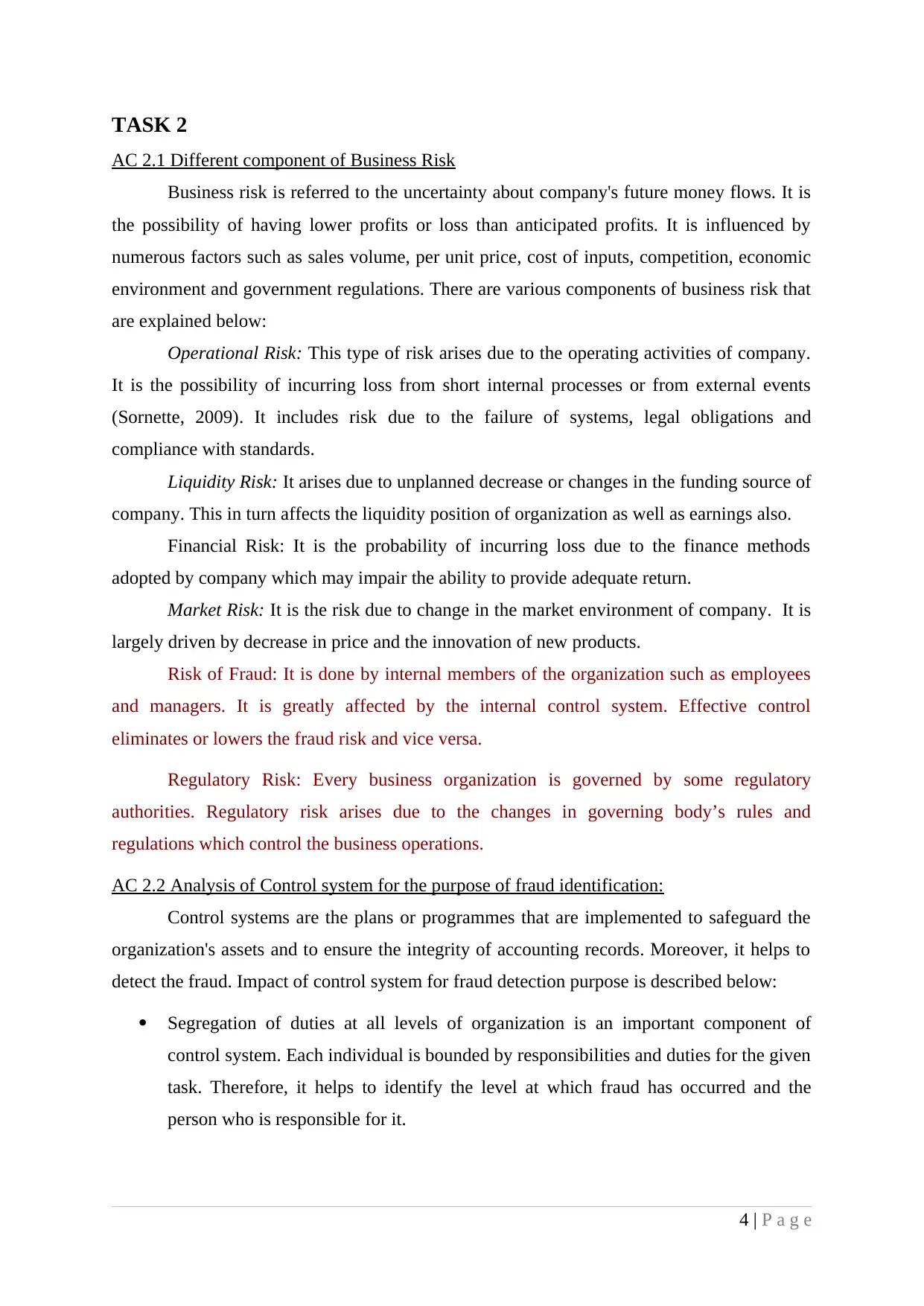
TASK 2
AC 2.1 Different component of Business Risk
Business risk is referred to the uncertainty about company's future money flows. It is
the possibility of having lower profits or loss than anticipated profits. It is influenced by
numerous factors such as sales volume, per unit price, cost of inputs, competition, economic
environment and government regulations. There are various components of business risk that
are explained below:
Operational Risk: This type of risk arises due to the operating activities of company.
It is the possibility of incurring loss from short internal processes or from external events
(Sornette, 2009). It includes risk due to the failure of systems, legal obligations and
compliance with standards.
Liquidity Risk: It arises due to unplanned decrease or changes in the funding source of
company. This in turn affects the liquidity position of organization as well as earnings also.
Financial Risk: It is the probability of incurring loss due to the finance methods
adopted by company which may impair the ability to provide adequate return.
Market Risk: It is the risk due to change in the market environment of company. It is
largely driven by decrease in price and the innovation of new products.
Risk of Fraud: It is done by internal members of the organization such as employees
and managers. It is greatly affected by the internal control system. Effective control
eliminates or lowers the fraud risk and vice versa.
Regulatory Risk: Every business organization is governed by some regulatory
authorities. Regulatory risk arises due to the changes in governing body’s rules and
regulations which control the business operations.
AC 2.2 Analysis of Control system for the purpose of fraud identification:
Control systems are the plans or programmes that are implemented to safeguard the
organization's assets and to ensure the integrity of accounting records. Moreover, it helps to
detect the fraud. Impact of control system for fraud detection purpose is described below:
Segregation of duties at all levels of organization is an important component of
control system. Each individual is bounded by responsibilities and duties for the given
task. Therefore, it helps to identify the level at which fraud has occurred and the
person who is responsible for it.
4 | P a g e
AC 2.1 Different component of Business Risk
Business risk is referred to the uncertainty about company's future money flows. It is
the possibility of having lower profits or loss than anticipated profits. It is influenced by
numerous factors such as sales volume, per unit price, cost of inputs, competition, economic
environment and government regulations. There are various components of business risk that
are explained below:
Operational Risk: This type of risk arises due to the operating activities of company.
It is the possibility of incurring loss from short internal processes or from external events
(Sornette, 2009). It includes risk due to the failure of systems, legal obligations and
compliance with standards.
Liquidity Risk: It arises due to unplanned decrease or changes in the funding source of
company. This in turn affects the liquidity position of organization as well as earnings also.
Financial Risk: It is the probability of incurring loss due to the finance methods
adopted by company which may impair the ability to provide adequate return.
Market Risk: It is the risk due to change in the market environment of company. It is
largely driven by decrease in price and the innovation of new products.
Risk of Fraud: It is done by internal members of the organization such as employees
and managers. It is greatly affected by the internal control system. Effective control
eliminates or lowers the fraud risk and vice versa.
Regulatory Risk: Every business organization is governed by some regulatory
authorities. Regulatory risk arises due to the changes in governing body’s rules and
regulations which control the business operations.
AC 2.2 Analysis of Control system for the purpose of fraud identification:
Control systems are the plans or programmes that are implemented to safeguard the
organization's assets and to ensure the integrity of accounting records. Moreover, it helps to
detect the fraud. Impact of control system for fraud detection purpose is described below:
Segregation of duties at all levels of organization is an important component of
control system. Each individual is bounded by responsibilities and duties for the given
task. Therefore, it helps to identify the level at which fraud has occurred and the
person who is responsible for it.
4 | P a g e
⊘ This is a preview!⊘
Do you want full access?
Subscribe today to unlock all pages.

Trusted by 1+ million students worldwide
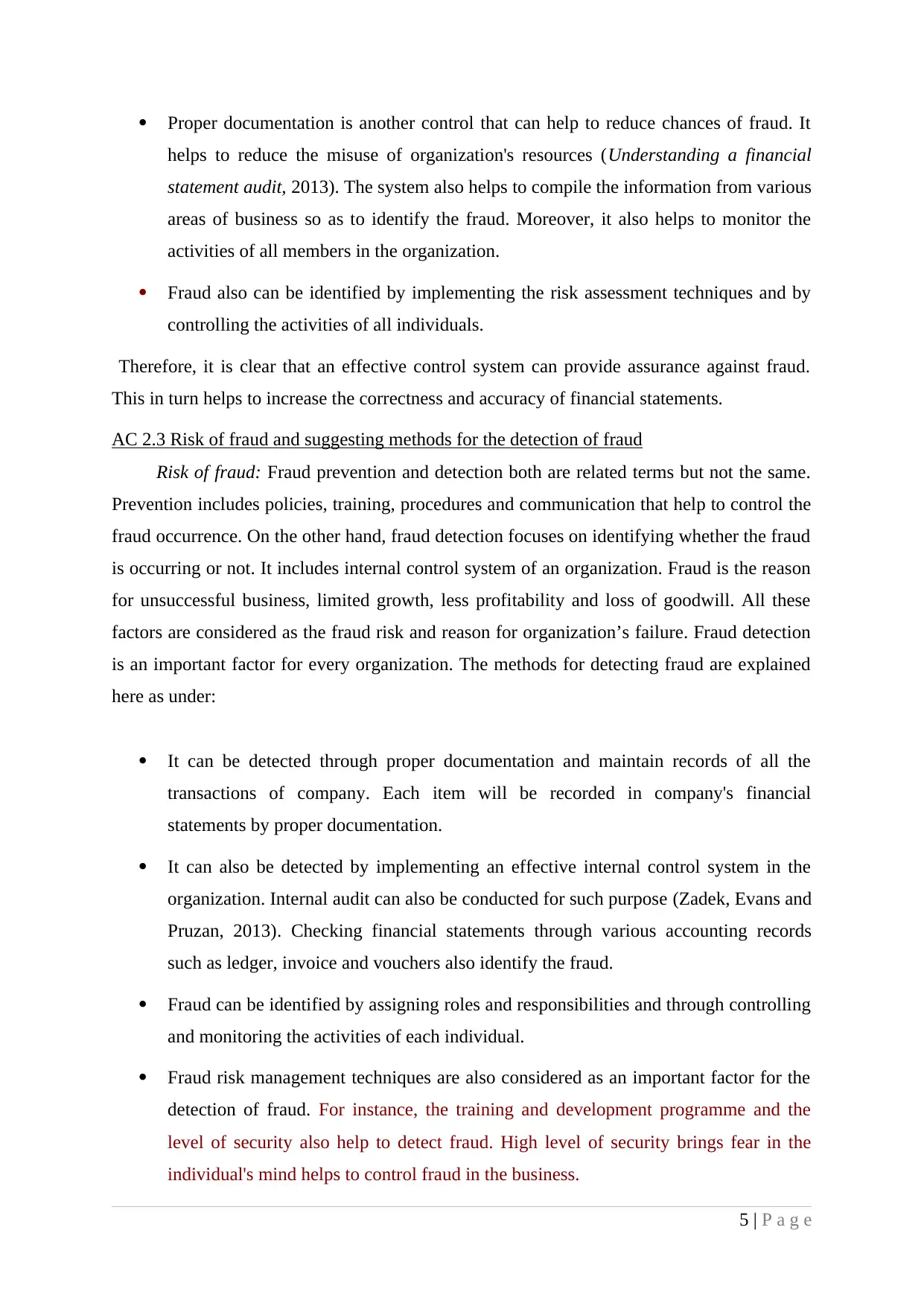
Proper documentation is another control that can help to reduce chances of fraud. It
helps to reduce the misuse of organization's resources (Understanding a financial
statement audit, 2013). The system also helps to compile the information from various
areas of business so as to identify the fraud. Moreover, it also helps to monitor the
activities of all members in the organization.
Fraud also can be identified by implementing the risk assessment techniques and by
controlling the activities of all individuals.
Therefore, it is clear that an effective control system can provide assurance against fraud.
This in turn helps to increase the correctness and accuracy of financial statements.
AC 2.3 Risk of fraud and suggesting methods for the detection of fraud
Risk of fraud: Fraud prevention and detection both are related terms but not the same.
Prevention includes policies, training, procedures and communication that help to control the
fraud occurrence. On the other hand, fraud detection focuses on identifying whether the fraud
is occurring or not. It includes internal control system of an organization. Fraud is the reason
for unsuccessful business, limited growth, less profitability and loss of goodwill. All these
factors are considered as the fraud risk and reason for organization’s failure. Fraud detection
is an important factor for every organization. The methods for detecting fraud are explained
here as under:
It can be detected through proper documentation and maintain records of all the
transactions of company. Each item will be recorded in company's financial
statements by proper documentation.
It can also be detected by implementing an effective internal control system in the
organization. Internal audit can also be conducted for such purpose (Zadek, Evans and
Pruzan, 2013). Checking financial statements through various accounting records
such as ledger, invoice and vouchers also identify the fraud.
Fraud can be identified by assigning roles and responsibilities and through controlling
and monitoring the activities of each individual.
Fraud risk management techniques are also considered as an important factor for the
detection of fraud. For instance, the training and development programme and the
level of security also help to detect fraud. High level of security brings fear in the
individual's mind helps to control fraud in the business.
5 | P a g e
helps to reduce the misuse of organization's resources (Understanding a financial
statement audit, 2013). The system also helps to compile the information from various
areas of business so as to identify the fraud. Moreover, it also helps to monitor the
activities of all members in the organization.
Fraud also can be identified by implementing the risk assessment techniques and by
controlling the activities of all individuals.
Therefore, it is clear that an effective control system can provide assurance against fraud.
This in turn helps to increase the correctness and accuracy of financial statements.
AC 2.3 Risk of fraud and suggesting methods for the detection of fraud
Risk of fraud: Fraud prevention and detection both are related terms but not the same.
Prevention includes policies, training, procedures and communication that help to control the
fraud occurrence. On the other hand, fraud detection focuses on identifying whether the fraud
is occurring or not. It includes internal control system of an organization. Fraud is the reason
for unsuccessful business, limited growth, less profitability and loss of goodwill. All these
factors are considered as the fraud risk and reason for organization’s failure. Fraud detection
is an important factor for every organization. The methods for detecting fraud are explained
here as under:
It can be detected through proper documentation and maintain records of all the
transactions of company. Each item will be recorded in company's financial
statements by proper documentation.
It can also be detected by implementing an effective internal control system in the
organization. Internal audit can also be conducted for such purpose (Zadek, Evans and
Pruzan, 2013). Checking financial statements through various accounting records
such as ledger, invoice and vouchers also identify the fraud.
Fraud can be identified by assigning roles and responsibilities and through controlling
and monitoring the activities of each individual.
Fraud risk management techniques are also considered as an important factor for the
detection of fraud. For instance, the training and development programme and the
level of security also help to detect fraud. High level of security brings fear in the
individual's mind helps to control fraud in the business.
5 | P a g e
Paraphrase This Document
Need a fresh take? Get an instant paraphrase of this document with our AI Paraphraser
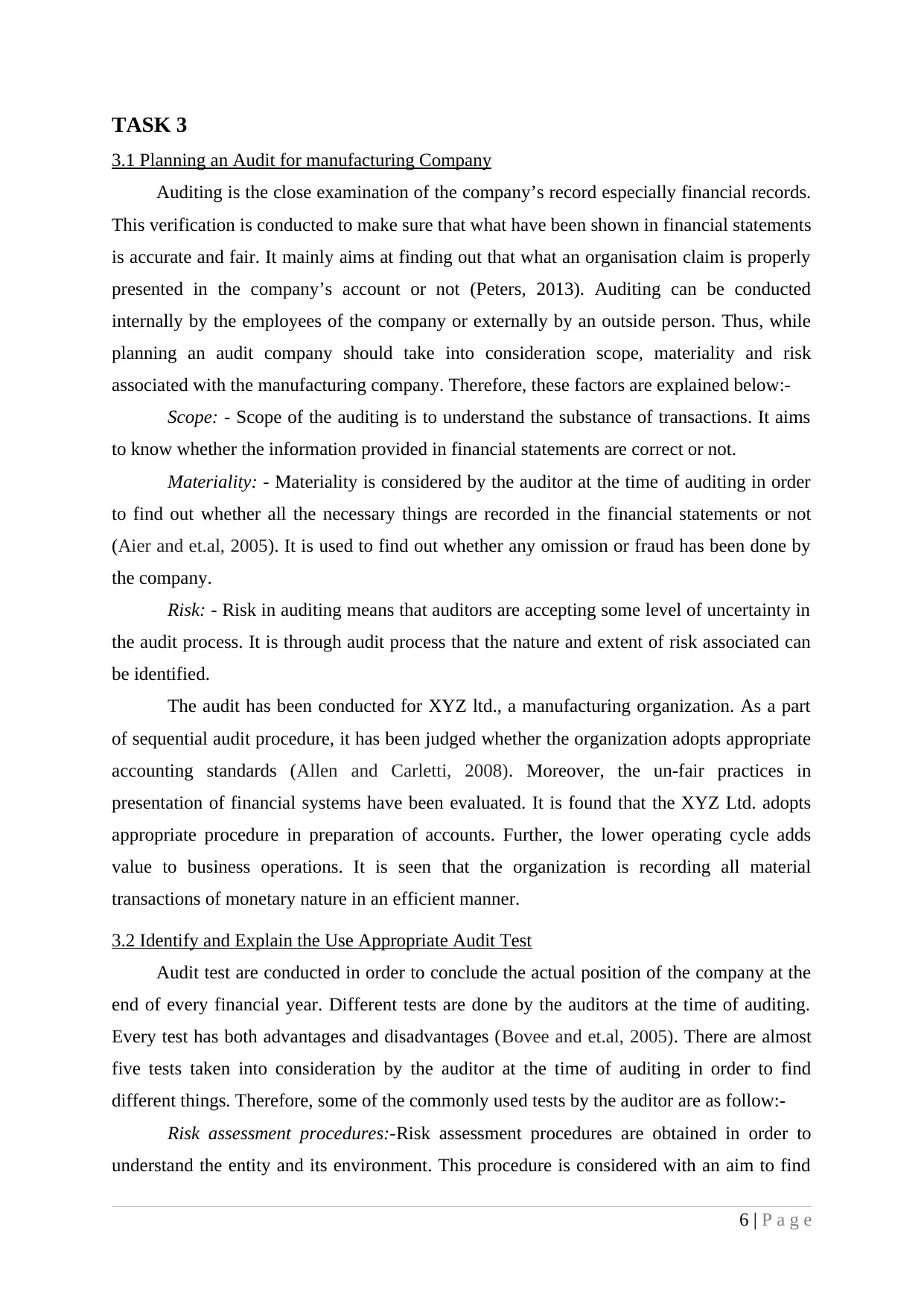
TASK 3
3.1 Planning an Audit for manufacturing Company
Auditing is the close examination of the company’s record especially financial records.
This verification is conducted to make sure that what have been shown in financial statements
is accurate and fair. It mainly aims at finding out that what an organisation claim is properly
presented in the company’s account or not (Peters, 2013). Auditing can be conducted
internally by the employees of the company or externally by an outside person. Thus, while
planning an audit company should take into consideration scope, materiality and risk
associated with the manufacturing company. Therefore, these factors are explained below:-
Scope: - Scope of the auditing is to understand the substance of transactions. It aims
to know whether the information provided in financial statements are correct or not.
Materiality: - Materiality is considered by the auditor at the time of auditing in order
to find out whether all the necessary things are recorded in the financial statements or not
(Aier and et.al, 2005). It is used to find out whether any omission or fraud has been done by
the company.
Risk: - Risk in auditing means that auditors are accepting some level of uncertainty in
the audit process. It is through audit process that the nature and extent of risk associated can
be identified.
The audit has been conducted for XYZ ltd., a manufacturing organization. As a part
of sequential audit procedure, it has been judged whether the organization adopts appropriate
accounting standards (Allen and Carletti, 2008). Moreover, the un-fair practices in
presentation of financial systems have been evaluated. It is found that the XYZ Ltd. adopts
appropriate procedure in preparation of accounts. Further, the lower operating cycle adds
value to business operations. It is seen that the organization is recording all material
transactions of monetary nature in an efficient manner.
3.2 Identify and Explain the Use Appropriate Audit Test
Audit test are conducted in order to conclude the actual position of the company at the
end of every financial year. Different tests are done by the auditors at the time of auditing.
Every test has both advantages and disadvantages (Bovee and et.al, 2005). There are almost
five tests taken into consideration by the auditor at the time of auditing in order to find
different things. Therefore, some of the commonly used tests by the auditor are as follow:-
Risk assessment procedures:-Risk assessment procedures are obtained in order to
understand the entity and its environment. This procedure is considered with an aim to find
6 | P a g e
3.1 Planning an Audit for manufacturing Company
Auditing is the close examination of the company’s record especially financial records.
This verification is conducted to make sure that what have been shown in financial statements
is accurate and fair. It mainly aims at finding out that what an organisation claim is properly
presented in the company’s account or not (Peters, 2013). Auditing can be conducted
internally by the employees of the company or externally by an outside person. Thus, while
planning an audit company should take into consideration scope, materiality and risk
associated with the manufacturing company. Therefore, these factors are explained below:-
Scope: - Scope of the auditing is to understand the substance of transactions. It aims
to know whether the information provided in financial statements are correct or not.
Materiality: - Materiality is considered by the auditor at the time of auditing in order
to find out whether all the necessary things are recorded in the financial statements or not
(Aier and et.al, 2005). It is used to find out whether any omission or fraud has been done by
the company.
Risk: - Risk in auditing means that auditors are accepting some level of uncertainty in
the audit process. It is through audit process that the nature and extent of risk associated can
be identified.
The audit has been conducted for XYZ ltd., a manufacturing organization. As a part
of sequential audit procedure, it has been judged whether the organization adopts appropriate
accounting standards (Allen and Carletti, 2008). Moreover, the un-fair practices in
presentation of financial systems have been evaluated. It is found that the XYZ Ltd. adopts
appropriate procedure in preparation of accounts. Further, the lower operating cycle adds
value to business operations. It is seen that the organization is recording all material
transactions of monetary nature in an efficient manner.
3.2 Identify and Explain the Use Appropriate Audit Test
Audit test are conducted in order to conclude the actual position of the company at the
end of every financial year. Different tests are done by the auditors at the time of auditing.
Every test has both advantages and disadvantages (Bovee and et.al, 2005). There are almost
five tests taken into consideration by the auditor at the time of auditing in order to find
different things. Therefore, some of the commonly used tests by the auditor are as follow:-
Risk assessment procedures:-Risk assessment procedures are obtained in order to
understand the entity and its environment. This procedure is considered with an aim to find
6 | P a g e
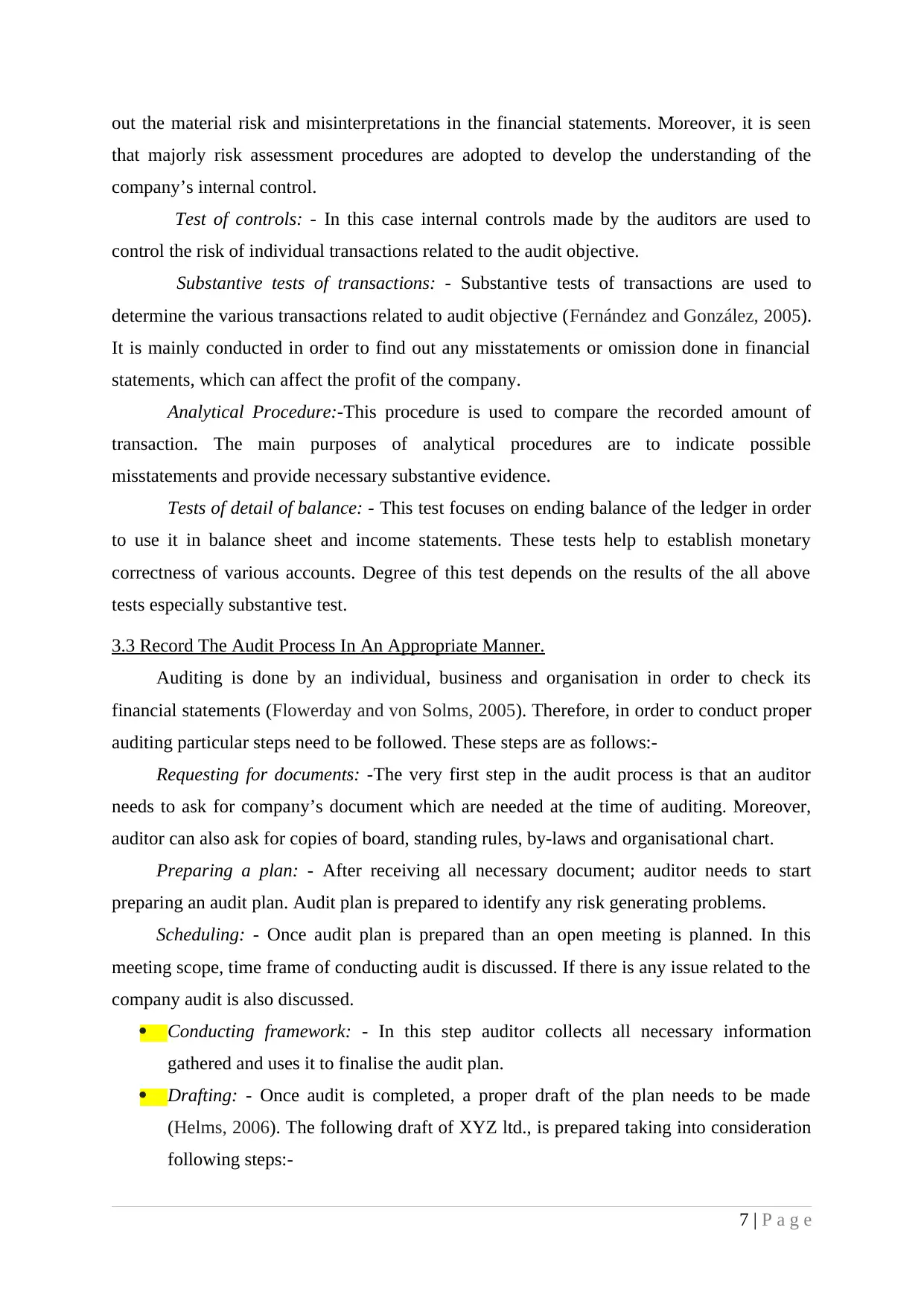
out the material risk and misinterpretations in the financial statements. Moreover, it is seen
that majorly risk assessment procedures are adopted to develop the understanding of the
company’s internal control.
Test of controls: - In this case internal controls made by the auditors are used to
control the risk of individual transactions related to the audit objective.
Substantive tests of transactions: - Substantive tests of transactions are used to
determine the various transactions related to audit objective (Fernández and González, 2005).
It is mainly conducted in order to find out any misstatements or omission done in financial
statements, which can affect the profit of the company.
Analytical Procedure:-This procedure is used to compare the recorded amount of
transaction. The main purposes of analytical procedures are to indicate possible
misstatements and provide necessary substantive evidence.
Tests of detail of balance: - This test focuses on ending balance of the ledger in order
to use it in balance sheet and income statements. These tests help to establish monetary
correctness of various accounts. Degree of this test depends on the results of the all above
tests especially substantive test.
3.3 Record The Audit Process In An Appropriate Manner.
Auditing is done by an individual, business and organisation in order to check its
financial statements (Flowerday and von Solms, 2005). Therefore, in order to conduct proper
auditing particular steps need to be followed. These steps are as follows:-
Requesting for documents: -The very first step in the audit process is that an auditor
needs to ask for company’s document which are needed at the time of auditing. Moreover,
auditor can also ask for copies of board, standing rules, by-laws and organisational chart.
Preparing a plan: - After receiving all necessary document; auditor needs to start
preparing an audit plan. Audit plan is prepared to identify any risk generating problems.
Scheduling: - Once audit plan is prepared than an open meeting is planned. In this
meeting scope, time frame of conducting audit is discussed. If there is any issue related to the
company audit is also discussed.
Conducting framework: - In this step auditor collects all necessary information
gathered and uses it to finalise the audit plan.
Drafting: - Once audit is completed, a proper draft of the plan needs to be made
(Helms, 2006). The following draft of XYZ ltd., is prepared taking into consideration
following steps:-
7 | P a g e
that majorly risk assessment procedures are adopted to develop the understanding of the
company’s internal control.
Test of controls: - In this case internal controls made by the auditors are used to
control the risk of individual transactions related to the audit objective.
Substantive tests of transactions: - Substantive tests of transactions are used to
determine the various transactions related to audit objective (Fernández and González, 2005).
It is mainly conducted in order to find out any misstatements or omission done in financial
statements, which can affect the profit of the company.
Analytical Procedure:-This procedure is used to compare the recorded amount of
transaction. The main purposes of analytical procedures are to indicate possible
misstatements and provide necessary substantive evidence.
Tests of detail of balance: - This test focuses on ending balance of the ledger in order
to use it in balance sheet and income statements. These tests help to establish monetary
correctness of various accounts. Degree of this test depends on the results of the all above
tests especially substantive test.
3.3 Record The Audit Process In An Appropriate Manner.
Auditing is done by an individual, business and organisation in order to check its
financial statements (Flowerday and von Solms, 2005). Therefore, in order to conduct proper
auditing particular steps need to be followed. These steps are as follows:-
Requesting for documents: -The very first step in the audit process is that an auditor
needs to ask for company’s document which are needed at the time of auditing. Moreover,
auditor can also ask for copies of board, standing rules, by-laws and organisational chart.
Preparing a plan: - After receiving all necessary document; auditor needs to start
preparing an audit plan. Audit plan is prepared to identify any risk generating problems.
Scheduling: - Once audit plan is prepared than an open meeting is planned. In this
meeting scope, time frame of conducting audit is discussed. If there is any issue related to the
company audit is also discussed.
Conducting framework: - In this step auditor collects all necessary information
gathered and uses it to finalise the audit plan.
Drafting: - Once audit is completed, a proper draft of the plan needs to be made
(Helms, 2006). The following draft of XYZ ltd., is prepared taking into consideration
following steps:-
7 | P a g e
⊘ This is a preview!⊘
Do you want full access?
Subscribe today to unlock all pages.

Trusted by 1+ million students worldwide
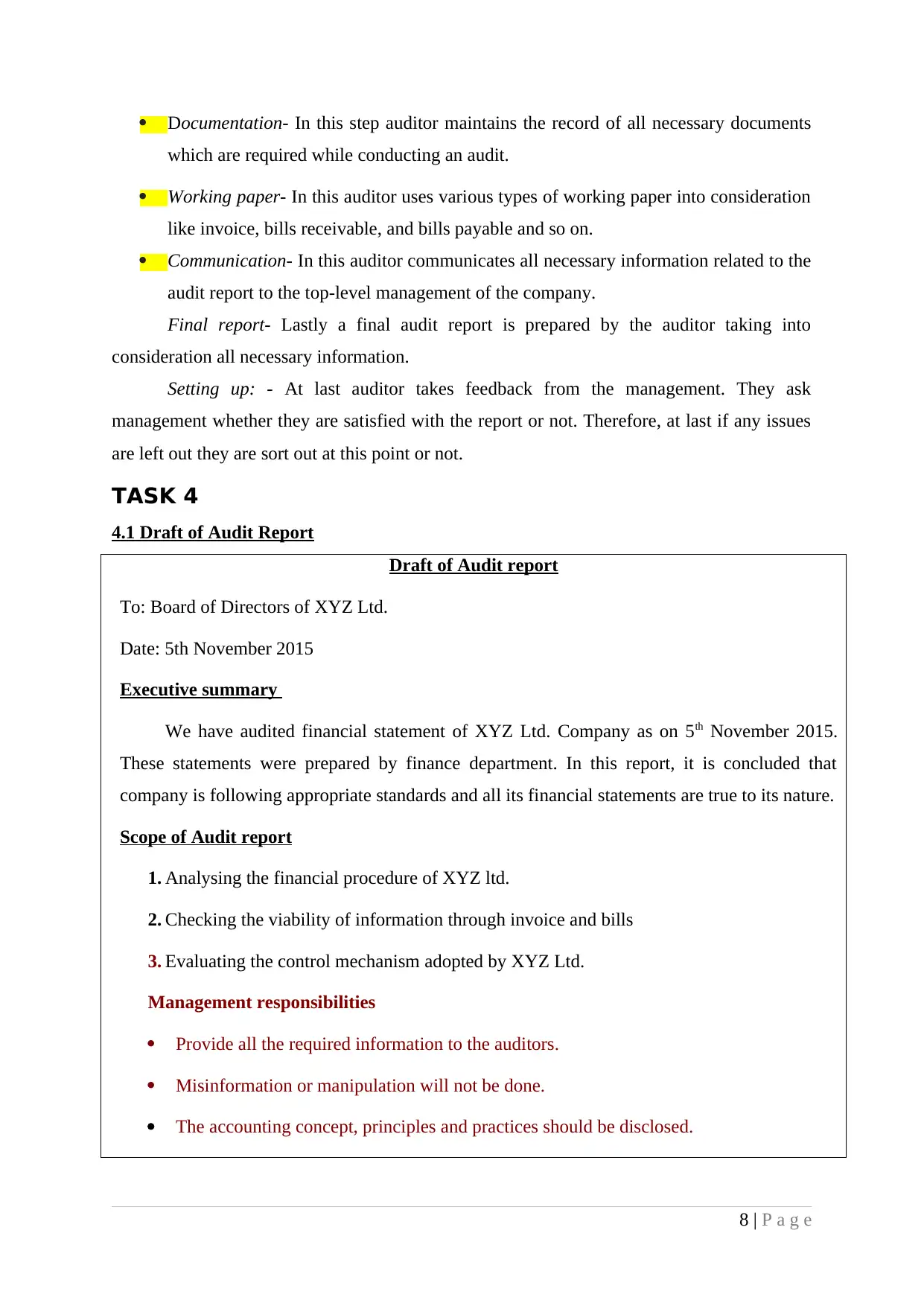
Documentation- In this step auditor maintains the record of all necessary documents
which are required while conducting an audit.
Working paper- In this auditor uses various types of working paper into consideration
like invoice, bills receivable, and bills payable and so on.
Communication- In this auditor communicates all necessary information related to the
audit report to the top-level management of the company.
Final report- Lastly a final audit report is prepared by the auditor taking into
consideration all necessary information.
Setting up: - At last auditor takes feedback from the management. They ask
management whether they are satisfied with the report or not. Therefore, at last if any issues
are left out they are sort out at this point or not.
TASK 4
4.1 Draft of Audit Report
Draft of Audit report
To: Board of Directors of XYZ Ltd.
Date: 5th November 2015
Executive summary
We have audited financial statement of XYZ Ltd. Company as on 5th November 2015.
These statements were prepared by finance department. In this report, it is concluded that
company is following appropriate standards and all its financial statements are true to its nature.
Scope of Audit report
1. Analysing the financial procedure of XYZ ltd.
2. Checking the viability of information through invoice and bills
3. Evaluating the control mechanism adopted by XYZ Ltd.
Management responsibilities
Provide all the required information to the auditors.
Misinformation or manipulation will not be done.
The accounting concept, principles and practices should be disclosed.
8 | P a g e
which are required while conducting an audit.
Working paper- In this auditor uses various types of working paper into consideration
like invoice, bills receivable, and bills payable and so on.
Communication- In this auditor communicates all necessary information related to the
audit report to the top-level management of the company.
Final report- Lastly a final audit report is prepared by the auditor taking into
consideration all necessary information.
Setting up: - At last auditor takes feedback from the management. They ask
management whether they are satisfied with the report or not. Therefore, at last if any issues
are left out they are sort out at this point or not.
TASK 4
4.1 Draft of Audit Report
Draft of Audit report
To: Board of Directors of XYZ Ltd.
Date: 5th November 2015
Executive summary
We have audited financial statement of XYZ Ltd. Company as on 5th November 2015.
These statements were prepared by finance department. In this report, it is concluded that
company is following appropriate standards and all its financial statements are true to its nature.
Scope of Audit report
1. Analysing the financial procedure of XYZ ltd.
2. Checking the viability of information through invoice and bills
3. Evaluating the control mechanism adopted by XYZ Ltd.
Management responsibilities
Provide all the required information to the auditors.
Misinformation or manipulation will not be done.
The accounting concept, principles and practices should be disclosed.
8 | P a g e
Paraphrase This Document
Need a fresh take? Get an instant paraphrase of this document with our AI Paraphraser
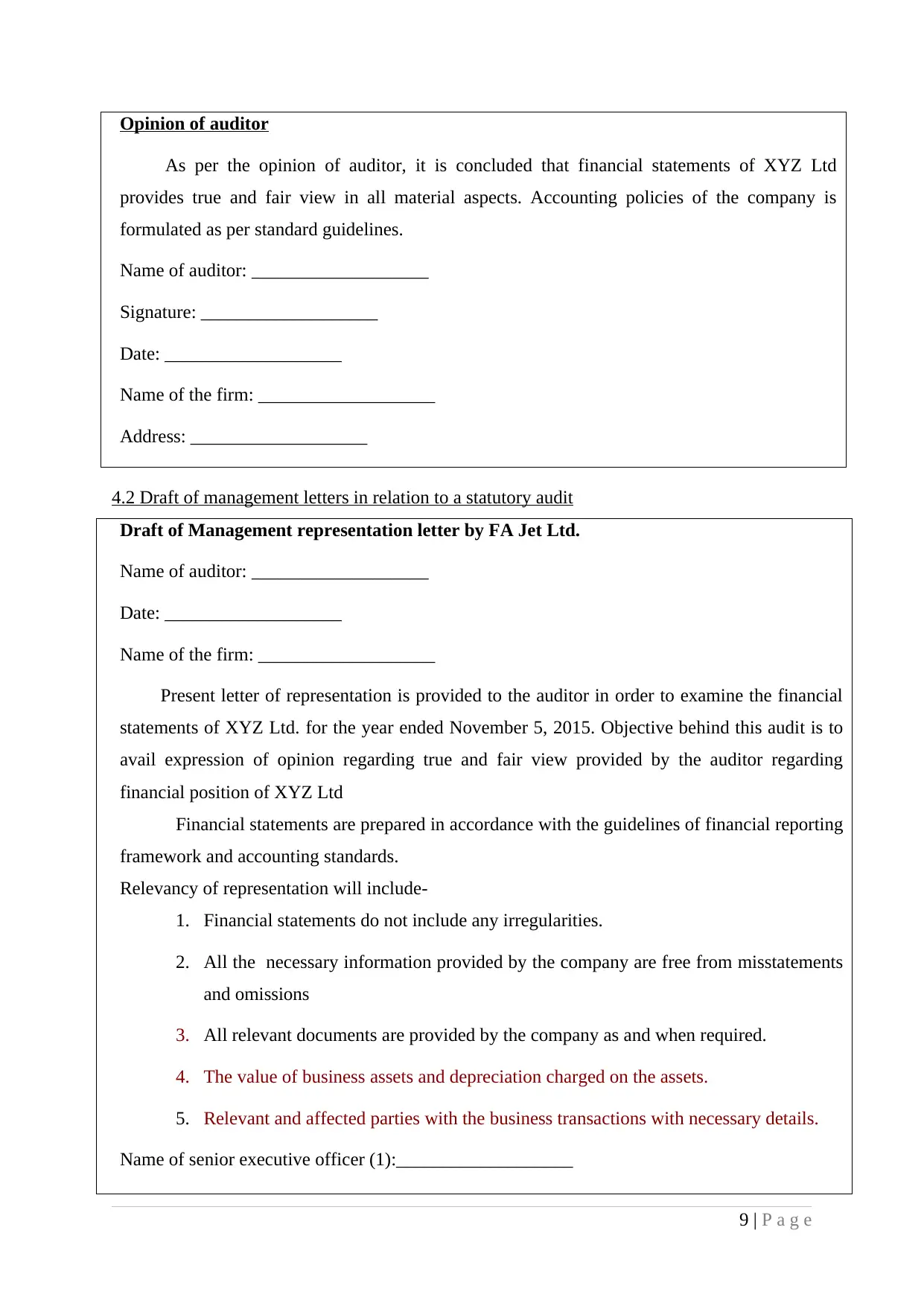
Opinion of auditor
As per the opinion of auditor, it is concluded that financial statements of XYZ Ltd
provides true and fair view in all material aspects. Accounting policies of the company is
formulated as per standard guidelines.
Name of auditor: ___________________
Signature: ___________________
Date: ___________________
Name of the firm: ___________________
Address: ___________________
4.2 Draft of management letters in relation to a statutory audit
Draft of Management representation letter by FA Jet Ltd.
Name of auditor: ___________________
Date: ___________________
Name of the firm: ___________________
Present letter of representation is provided to the auditor in order to examine the financial
statements of XYZ Ltd. for the year ended November 5, 2015. Objective behind this audit is to
avail expression of opinion regarding true and fair view provided by the auditor regarding
financial position of XYZ Ltd
Financial statements are prepared in accordance with the guidelines of financial reporting
framework and accounting standards.
Relevancy of representation will include-
1. Financial statements do not include any irregularities.
2. All the necessary information provided by the company are free from misstatements
and omissions
3. All relevant documents are provided by the company as and when required.
4. The value of business assets and depreciation charged on the assets.
5. Relevant and affected parties with the business transactions with necessary details.
Name of senior executive officer (1):___________________
9 | P a g e
As per the opinion of auditor, it is concluded that financial statements of XYZ Ltd
provides true and fair view in all material aspects. Accounting policies of the company is
formulated as per standard guidelines.
Name of auditor: ___________________
Signature: ___________________
Date: ___________________
Name of the firm: ___________________
Address: ___________________
4.2 Draft of management letters in relation to a statutory audit
Draft of Management representation letter by FA Jet Ltd.
Name of auditor: ___________________
Date: ___________________
Name of the firm: ___________________
Present letter of representation is provided to the auditor in order to examine the financial
statements of XYZ Ltd. for the year ended November 5, 2015. Objective behind this audit is to
avail expression of opinion regarding true and fair view provided by the auditor regarding
financial position of XYZ Ltd
Financial statements are prepared in accordance with the guidelines of financial reporting
framework and accounting standards.
Relevancy of representation will include-
1. Financial statements do not include any irregularities.
2. All the necessary information provided by the company are free from misstatements
and omissions
3. All relevant documents are provided by the company as and when required.
4. The value of business assets and depreciation charged on the assets.
5. Relevant and affected parties with the business transactions with necessary details.
Name of senior executive officer (1):___________________
9 | P a g e
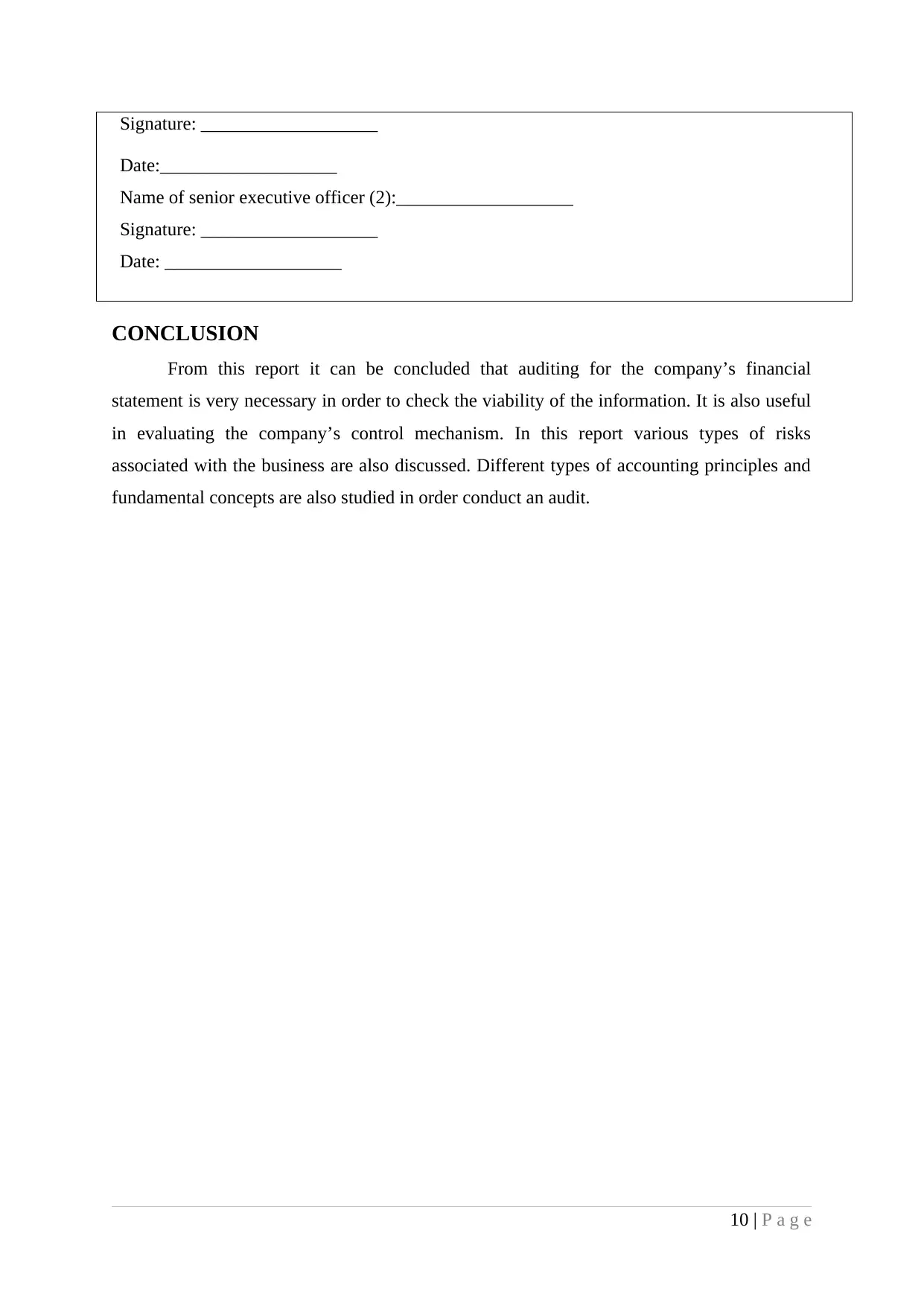
Signature: ___________________
Date:___________________
Name of senior executive officer (2):___________________
Signature: ___________________
Date: ___________________
CONCLUSION
From this report it can be concluded that auditing for the company’s financial
statement is very necessary in order to check the viability of the information. It is also useful
in evaluating the company’s control mechanism. In this report various types of risks
associated with the business are also discussed. Different types of accounting principles and
fundamental concepts are also studied in order conduct an audit.
10 | P a g e
Date:___________________
Name of senior executive officer (2):___________________
Signature: ___________________
Date: ___________________
CONCLUSION
From this report it can be concluded that auditing for the company’s financial
statement is very necessary in order to check the viability of the information. It is also useful
in evaluating the company’s control mechanism. In this report various types of risks
associated with the business are also discussed. Different types of accounting principles and
fundamental concepts are also studied in order conduct an audit.
10 | P a g e
⊘ This is a preview!⊘
Do you want full access?
Subscribe today to unlock all pages.

Trusted by 1+ million students worldwide
1 out of 13
Related Documents
Your All-in-One AI-Powered Toolkit for Academic Success.
+13062052269
info@desklib.com
Available 24*7 on WhatsApp / Email
![[object Object]](/_next/static/media/star-bottom.7253800d.svg)
Unlock your academic potential
Copyright © 2020–2025 A2Z Services. All Rights Reserved. Developed and managed by ZUCOL.





